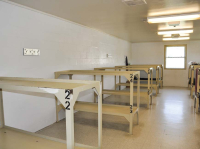The Naturalist's Corner: Winter miracle
It’s late January and it’s 15 degrees outside, snow is flying, the Alberta Clipper has the huge yellow buckeye swaying like the mast of a sailing ship but inside that yellow buckeye, a good 50 feet above ground in a cramped clawed out leaf-lined den, life will not be denied. A black bear is giving birth to two tiny, sightless, hairless cubs weighing maybe 10 ounces each. The cubs will be shifted quickly to their mother’s breast where their small round mouths will find teats and warm rich milk.
Black bear are found throughout North America, in suitable habitat, from Canada to Florida and from coast to coast. Most black bears hibernate for a period of time during winter. That time could range from seven months in Alaska and Canada to three to four months in the Southern Appalachians to zero months in Florida.
Pregnant females are generally the earliest hibernators followed by barren females and females with yearlings and lastly males. Black bears usually give birth from late December through February, with most cubs being born from mid- to late January. Even in southern states like Louisiana and Florida where bears can be active year round, pregnant females “den up” to give birth.
A den can be anything from a pile of leaves and sticks in a rhododendron slick for a bear in the Appalachians to a rock crevice in Maine to a cave in the Rockies to the roots of an upturned spruce in Canada. Pregnant females tend to select the most secure and protected dens and it is common in the Appalachians for these dens to be in cavities in large, mature hardwoods.
The debate, “Are black bears ‘true’ hibernators?” is still out there but it seems most wildlife biologists are expanding their definition and/or concept of hibernation to include black bears. One of the main sticking points is the fact that the bear’s body temperature does not drop as dramatically as that of other hibernators.
While the bear’s heart rate in hibernation may drop from between 45 to 70 beats per minute to between eight and 12 its temperature may only drop from 100 degrees Fahrenheit to between 86 and 96 degrees Fahrenheit.
Related Items
It’s this relatively high body temperature that allows the mother bear to be alert enough to care for her young. And that can be a demanding task. Newborns will nurse every 10 minutes or so. As they get older the intervals between feedings will grow giving the mom time to nap while the cubs nap.
It is also the bear’s body temperature that keeps the cubs warm. There is often little difference between outside temperatures and the temperature in the den. The mom turns her thickly furred back to the cold and curls up in a ball bringing the cubs close to her breast. Her body heat and warm breath help keep the cups warm. By the time the cubs are six weeks old they are also covered with a dense fur.
The bear’s milk is metabolized directly from body fat and is nearly twice as high in calories as human milk and/or cow’s milk. The bear may lose as much as half a pound a day in weight as it converts its body fat into milk. The mother bear may produce as much as 50 pounds of milk before the winter is over.
Female black bears become sexually mature at around four years old. They typically have one cub their first pregnancy. Since they care for their cubs for a year or so, sexually mature bears generally give birth every other year. Litters can range from one to four with two being the average here in the Southern Appalachians.
As the cubs grow they become more and more active in the den and if the den is at ground level, they may actually venture outside occasionally by early March. Most bear families are out of the den by late April. The cubs will weigh between nine and 12 pounds and it will be time for mom to find some food and show them the ropes.
Don Hendershot can be reached at This email address is being protected from spambots. You need JavaScript enabled to view it.









